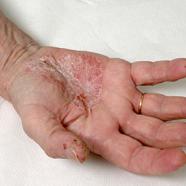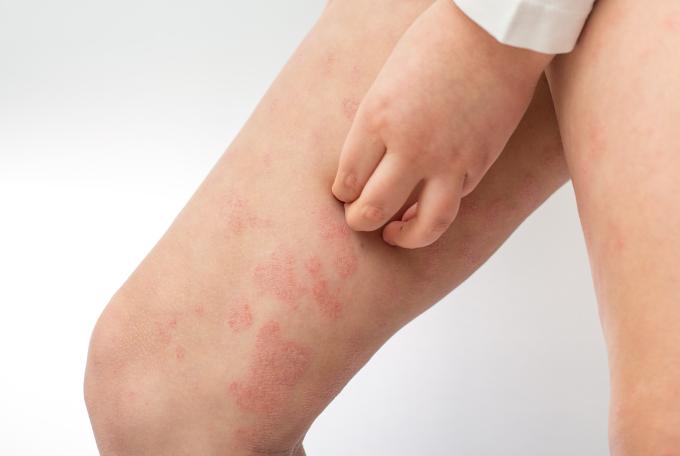
Eczema & Atopic Dermatitis
In France, 2.5 million adults suffer from atopic dermatitis, which is a form of eczema, but also 10% to 15% of children under the age of 3 are affected by this skin condition, which may not be serious but can be severely debilitating. The prevalence of this chronic disease makes it a real public health problem. However, there are treatments that improve patients' symptoms and quality of life.

What is eczema?
First of all, let's discuss the cause. There is a scientific consensus that this skin condition is caused by a genetic anomaly, with a deficiency of certain components of the skin. There is onset of major skin dryness, leaving the skin less able to protect against the irritants, allergens and pollutants that can penetrate it more easily.
This can include anything in the environment, inside a home, such as pollen, dust, dust mites and food allergens. The immune system then reacts excessively by producing significant amounts of immunoglobulin E antibodies, manifesting clinically by the appearance of eczema patches on the face, hands and feet.
The different types of eczema
Dermatologists who are familiar with this condition categorise it into several types :

Atopic eczema
- This is the most common form, and it is the cutaneous manifestation of atopy, hence the name. It is sometimes associated with other disorders, such as asthma. It can appear on various areas of the body such as the face, hands, feet, arms, legs and sometimes on the trunk.
Contact dermatitis
- This type of eczema appears following direct contact of the skin with an allergic or irritant product such as certain metals (jewellery containing nickel, etc.). Erythema (redness) appears on the area of skin in contact with the triggering agent. This redness disappears after the product is eliminated. This often affects hands that are exposed to different substances through handling, but contact dermatitis can also affect other areas, especially when allergenic or irritant substances are airborne (transported by air)
There are other types of eczema that are more rare.
These include



The symptoms of eczema
A clinical examination of the affected areas carried out by a dermatologist will make a diagnosis of eczema possible. This disease is actually an inflammatory skin reaction that manifests itself in the form of plaques. The clinical signs usually fall into 3 types :
- redness,
- swelling,
- itching
It should be noted that these plaques can weep with unintentional scratching, peel or form scabs, and thicken if the eczema is chronic. This is called lichenification.
It is also important to remember that the course of the disease, as is often the case in the various types of eczema, consists of flare-ups, with plaques appearing, fading and then reappearing.
Prevention and treatment of eczema.
The origin of atopic eczema is an anomaly in the formation of the skin. There is no cure, but symptomatic treatments are available to relieve symptoms :

Anti-inflammatory drugs
They are prescribed to treat affected skin areas. They are topically applied corticosteroids in the form of creams, ointments or lotions. The doctor will inform the patient where to apply it and the duration of the treatment. Usually, plaques react well and disappear by the end of the treatment when the instructions are correctly followed. However, they may reappear later due to the chronic nature and flare-up course of the disease. If the lesions persist, the dermatologist may need to adjust the treatment.


Healthy lifestyle
It has been shown that a balanced diet, without excess, that is high in fibre and low in sugar, with an increased intake of certain nutrients and essential fatty acids like omega-3 and omega-6 rich in gamma-linoleic acid (AGL) can prevent the exacerbation of eczema outbreaks. These are found in flax oil, borage oil, nuts and oily fish. It is also possible to take them in food supplements.

Another point to consider is managing your home environment.
This means avoiding living in an atmosphere that is too dry, or with high levels of dust and dust mites. Bedding, carpets, etc. should be kept free of them by vacuuming daily in the bedrooms.
Personal hygiene is also important. Choose suitable soap-free hygiene products formulated and tested on atopic skin with the shortest possible list of ingredients.
Stress and atopic eczema
Stress is not the cause of atopic eczema, but it is an aggravating factor that can trigger a relapse. Also, learning to manage stress using various means or gentle techniques, such as relaxation and sophrology, can be a way to improve day-to-day life with skin that overreacts to its environment.
The Eczema Foundation
The Eczema Foundation, previously the Foundation for Atopic Dermatitis, was created in 2004 by Pierre Fabre, founder of the Laboratoires Pierre Fabre group that bears his name. It has general interest focus, through which it is committed to therapeutic patient education, information and research in the field of eczema.
In partnership with healthcare professionals and patient associations, the foundation has formed an alliance to alleviate the burden of patients living with this disease. Its goals are divided into various actions :
- Supporting patients to take ownership of their disease.
- Acting as the mediator of an alliance between patients and healthcare professionals.
- Bringing together healthcare professionals and academics.
- Contributing to a consensus-based approach to eczema shared and understood by all.
- Passing on knowledge about eczema and raising awareness about this disease.
- Participating in research around eczema.
For more information : www.pierrefabreeczemafoundation.org








